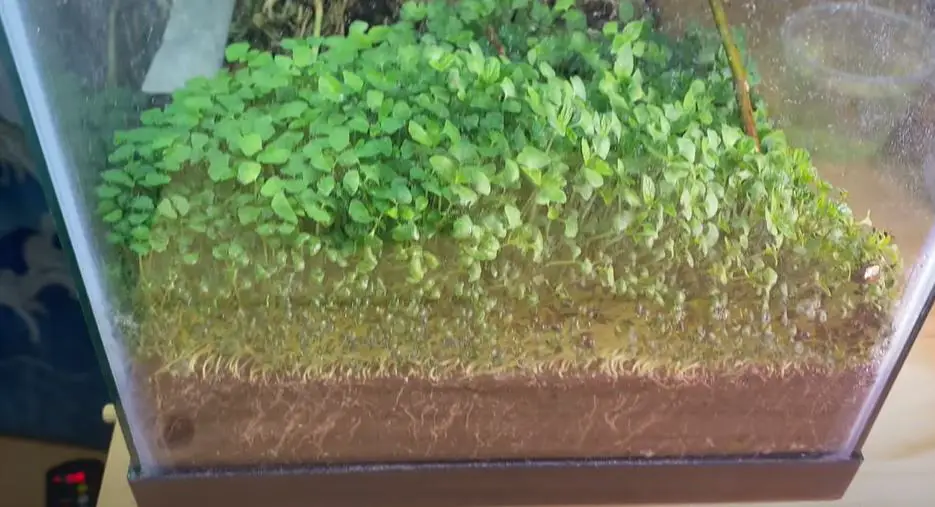Looking to add some lush greenery to your aquarium? Wondering how to plant aquarium grass seeds to create a vibrant underwater landscape? You’re in the right place! In this article, we’ll guide you through the simple steps of planting aquarium grass seeds, helping you transform your aquatic haven into a breathtaking sight.
From selecting the right seeds to creating the ideal environment for growth, we’ve got you covered. So, let’s dive right in and learn how to plant aquarium grass seeds for a stunning aquatic display that will captivate all who see it.
How to Plant Aquarium Grass Seeds
Aquarium grass can add natural beauty and vibrancy to your fish tank. Not only does it enhance the overall aesthetics, but it also serves as a beneficial component of a healthy aquarium ecosystem.
Planting aquarium grass seeds may seem like a daunting task, but with the right knowledge and techniques, you can create a lush green carpet in your underwater paradise.
In this article, we will guide you through the step-by-step process of planting aquarium grass seeds, from selecting the right seeds to maintaining a thriving grass bed.
Choosing the Right Aquarium Grass Seeds
The first and crucial step in planting aquarium grass seeds is to choose the right type of grass for your tank. Some popular options include:
- Java Moss (Taxiphyllum barbieri):
A versatile and hardy plant that is easy to care for and suitable for beginners.
- Dwarf Hairgrass (Eleocharis parvula):
Known for its carpet-like appearance, this grass requires more attention but offers a stunning visual impact.
- Amazon Sword (Echinodorus amazonicus):
A larger grass variety that creates a beautiful background in the tank.
When selecting aquarium grass seeds, consider the specific requirements of your fish species, the tank size, and the overall aesthetic you want to achieve.
Research each type to determine its growth rate, lighting needs, and compatibility with your existing aquatic environment.
Read More: About Exploring The Fascinating Corn Plant Stalk With No Leaves
Gathering the Required Materials
Before you start the planting process, it’s essential to gather all the necessary materials. Here’s a list of items you will need:
- Aquarium
Select a suitable aquarium size based on the type and quantity of grass you intend to plant.
- Substrate
Choose an appropriate substrate, such as aquarium soil or gravel, to provide the necessary nutrients for the grass seeds.
- Lighting
Ensure that your aquarium has proper lighting to support the growth of aquarium grass. LED lights are often recommended for their energy efficiency and ability to promote plant growth.
- Fertilizers
Depending on the grass species you choose, you may need to add liquid or root fertilizer to supplement the nutrient levels in the tank.
- Tweezers or Planting Tools
These tools will help you plant the grass seeds precisely and without disturbing the surrounding environment.
- Water Conditioner
Prepare the aquarium water by using a water conditioner to remove chlorine and other harmful substances that may hinder plant growth.
Preparing the Aquarium for Planting
Now that you have gathered all the necessary materials, it’s time to prepare your aquarium for planting aquarium grass seeds. Follow these steps:
- Clean the Aquarium
Ensure that the tank is clean and free from any debris or previous plant remains. A clean environment will promote healthy growth.
- Install the Substrate
Place the chosen substrate in the aquarium. Depending on the grass species, a layer of 1-2 inches should be sufficient. Spread the substrate evenly across the tank’s bottom.
- Add Water
Fill the aquarium with dechlorinated water. The water level should be slightly above the substrate to prevent it from floating or being disturbed during planting.
- Install Lighting
Set up the lighting system above the aquarium according to the specific requirements of the grass species you have chosen. Ensure that the light is evenly distributed throughout the tank.
- Condition the Water
Treat the water with a water conditioner to remove any chlorine or heavy metals that could be harmful to the grass seeds.
Planting the Aquarium Grass Seeds
With the aquarium prepared, it’s time to plant the grass seeds. Follow these steps for successful planting:
- Prepare the Seeds
If you have purchased dry seeds, soak them in water for a few hours to hydrate them before planting. Live seeds may not require soaking.
Divide Seeds into Smaller Portions
If you have a large quantity of seeds, divide them into smaller portions to facilitate planting and ensure even distribution.
Use Tweezers or Planting Tools
With the tweezers or planting tools, carefully insert the seeds into the desired spots on the substrate. Plant them at a depth of about 1-2 inches or according to the specific requirements of the grass species.
- Plant in Rows or Patterns:
For a more organized and visually appealing look, consider planting the seeds in rows or patterns, ensuring adequate spacing between each seed.
- Gently Press Seeds into the Substrate
Once the seeds are in position, gently press them into the substrate to secure their position and promote contact with the nutrients.
Caring for the Planted Aquarium Grass Seeds
After planting the aquarium grass seeds, it’s important to provide proper care to ensure their healthy growth. Consider the following care guidelines
- Provide Adequate Lighting
Ensure that the aquarium receives the appropriate amount of light for the specific grass species. Most aquarium grasses require 10-12 hours of light per day.
- Maintain Water Temperature
Monitor and maintain the water temperature within the appropriate range for your fish species and grass variety. Most aquarium grasses thrive in water temperatures between 72-82°F (22-28°C).
- Regular Water Changes
Perform regular water changes to maintain optimal water quality. This helps remove any accumulated toxins or excess nutrients that could hinder the growth of the grass.
- Fertilize as Needed
Depending on the grass species, consider adding liquid or root fertilizers as recommended. This will supplement the nutrient levels in the aquarium and promote healthy growth.
- Prune and Trim
As the grass grows, it may require occasional pruning to maintain the desired shape and prevent overcrowding. Use sharp scissors or pruning tools to trim any excessive growth.
- Monitor and Adjust
Regularly monitor the growth and condition of the aquarium grass. Adjust lighting, fertilization, and other care parameters as needed to ensure optimal growth.
By following these planting and care guidelines, you can establish a beautiful and thriving aquarium grass bed. Remember to have patience, as it may take several weeks for the seeds to sprout and establish themselves.
With proper care and maintenance, you can enjoy a lush and vibrant underwater landscape in your aquarium.
Read More: About How To Keep Grass Out Of Wildflowers?
Frequently Asked Questions (FAQs)
To plant aquarium grass seeds, follow these steps:
Prepare the substrate by rinsing it thoroughly to remove any debris or dirt.
Add a layer of nutrient-rich soil to the bottom of the aquarium, ensuring it covers the area where you want to plant the grass seeds.
Spread a thin layer of fine gravel or sand on top of the soil to prevent it from floating up when you add water.
Fill the aquarium with water, ensuring the water level is about 2-3 inches above the substrate.
Scatter the aquarium grass seeds evenly on top of the substrate.
Cover the seeds with a thin layer of gravel or sand.
Install a suitable aquarium light that provides the necessary intensity and spectrum for the grass seeds to grow.
Keep the water temperature between 72-82°F (22-28°C) and maintain good water circulation.
Monitor the growth of the grass seeds and adjust lighting and fertilization if necessary.
A nutrient-rich substrate is best for planting aquarium grass seeds. You can use specialized aquarium soil or a mixture of soil and inert substrate like sand or gravel. This type of substrate provides the necessary nutrients for the grass seeds to establish and grow.
The growth time for aquarium grass seeds can vary depending on the species and environmental conditions. Generally, it can take a few weeks to a couple of months for the seeds to germinate and establish roots. Full growth and carpet-like coverage may take several months.
Using CO2 injection can promote faster and healthier growth of aquarium grass seeds. However, it is not always necessary, especially for low to medium light setups. If you have high light intensity and want faster growth, CO2 injection can be beneficial. Otherwise, adequate lighting and nutrient-rich substrate should be sufficient for successful growth.
Fertilizing frequency depends on the type of fertilizer you are using and the specific needs of the aquarium grass seeds. Generally, it is recommended to follow the fertilizer manufacturer’s instructions for dosage and frequency. Regularly monitor the growth and health of the plants, and adjust fertilization as needed.
Adequate lighting is crucial for the healthy growth of aquarium grass seeds. Without proper lighting, the seeds may not receive enough energy for photosynthesis and can struggle to grow. Invest in a suitable aquarium light that provides the necessary intensity and spectrum for the specific species of grass seeds you are planting.
It is not necessary to cover the entire aquarium when planting grass seeds. Instead, make sure the seeds are covered with a thin layer of gravel or sand to protect them and prevent them from floating up. The cover helps maintain the appropriate conditions for germination and root development.
To prevent algae growth when planting aquarium grass seeds, follow these tips:
Ensure proper lighting duration and intensity according to the specific needs of the grass seeds.
Maintain good water circulation and consider adding a gentle water flow or using a filter.
Avoid overfeeding fish and remove any excess food promptly.
Regularly perform water changes to maintain water quality and remove excess nutrients.
Consider adding live aquarium plants that compete with algae for nutrients.
Final Thoughts
To plant aquarium grass seeds, start by preparing a suitable substrate in your aquarium. Make sure it is nutrient-rich to provide the necessary sustenance for the seeds to germinate and grow. Next, scatter the grass seeds evenly across the substrate, taking care not to bury them too deep. Gently mist the seeds with water to keep them moist and encourage germination.
Maintain the ideal conditions by providing adequate lighting, CO2 supplementation, and regular fertilization. Within a few weeks, you will witness the beautiful growth of your aquarium grass seeds, transforming your tank into a lush and vibrant underwater landscape.
Auto Amazon Links: No products found.
Perfect Plants Christmas Tree Saver 8oz. | Easy Use Xmas Tree Preserver Food | Have Healthy Green Christmas Trees All Holiday Season
$9.97 (as of December 5, 2025 00:43 GMT +00:00 - More info- Product prices and availability are accurate as of the date/time indicated and are subject to change. Any price and availability information displayed on [relevant Amazon Site(s), as applicable] at the time of purchase will apply to the purchase of this product.
Kaiedos Christmas Tree Watering Funnel - 39 Inch Funnel, Reusable Design, Makes Watering Your Live Tree a Snap!
$14.99 (as of December 5, 2025 00:43 GMT +00:00 - More info- Product prices and availability are accurate as of the date/time indicated and are subject to change. Any price and availability information displayed on [relevant Amazon Site(s), as applicable] at the time of purchase will apply to the purchase of this product.
Wilt-Pruf® Christmas Tree/Cutting Preserver Spray |Preserves Christmas Trees, Wreaths, Garlands, Cuttings and Carved Pumpkins | Reduces Needle Drop | Keeps Cut Trees Fresh Longer | Natural (32 oz)
$21.99 (as of December 5, 2025 00:43 GMT +00:00 - More info- Product prices and availability are accurate as of the date/time indicated and are subject to change. Any price and availability information displayed on [relevant Amazon Site(s), as applicable] at the time of purchase will apply to the purchase of this product.
Forest Fresh Christmas Tree Preservative Tablets – Tree Water Additive for Live Fresh-Cut Trees – Keeps Trees Hydrated and Reduces Needle Drop – Non-Toxic, Made in USA – 1 Packet (8 Tablets)
$5.99 (as of December 5, 2025 00:43 GMT +00:00 - More info- Product prices and availability are accurate as of the date/time indicated and are subject to change. Any price and availability information displayed on [relevant Amazon Site(s), as applicable] at the time of purchase will apply to the purchase of this product.
IPOOLTENG Christmas Tree Watering Funnel 3 Tube 1 Funnels 40 Inch - 3 Section Plastic Christmas Tree Funnel Waterer, Long Funnels for Watering Trees, Best Gifts for Your Parents to Water Tree
$14.53 (as of December 5, 2025 00:43 GMT +00:00 - More info- Product prices and availability are accurate as of the date/time indicated and are subject to change. Any price and availability information displayed on [relevant Amazon Site(s), as applicable] at the time of purchase will apply to the purchase of this product.
Snow Joe Premium Enviro Blend Ice Melt, Green-Coated Deicer Crystals, 50 lb - Safer Melter for Vegetation, Concrete & Metals w/ Anti-Corrosion Calcium Magnesium Acetate
$32.97 (as of December 5, 2025 17:01 GMT +00:00 - More info- Product prices and availability are accurate as of the date/time indicated and are subject to change. Any price and availability information displayed on [relevant Amazon Site(s), as applicable] at the time of purchase will apply to the purchase of this product.
Muddy Mat® Shown on TV Super Absorbent Microfiber Dog Door Mat for Muddy Paws, Non-Slip Washable Pet Rug, Quick Dry Chenille Entryway Carpet, Machine Washable Indoor Outdoor mat, Grey 30"x19"
$19.95 (as of December 5, 2025 17:01 GMT +00:00 - More info- Product prices and availability are accurate as of the date/time indicated and are subject to change. Any price and availability information displayed on [relevant Amazon Site(s), as applicable] at the time of purchase will apply to the purchase of this product.
Cuisinart 6.5" Cast Iron Smashed Burger Press, Round Flat Edge Grill Press for Crispy Smash Burgers, Burger Tool for Grill and Griddle Accessories, for BBQs and Tailgates
$24.99 (as of December 5, 2025 17:01 GMT +00:00 - More info- Product prices and availability are accurate as of the date/time indicated and are subject to change. Any price and availability information displayed on [relevant Amazon Site(s), as applicable] at the time of purchase will apply to the purchase of this product.
Zevo Flying Insect Trap Official Refill Cartridges - Fits Both Zevo Trap & MAX Indoor Fly Trap - Authentic Trap+Lock Technology to Catch Gnats, House & Fruit Flys (4 Official Refill Cartridges)
$13.47 (as of December 5, 2025 17:01 GMT +00:00 - More info- Product prices and availability are accurate as of the date/time indicated and are subject to change. Any price and availability information displayed on [relevant Amazon Site(s), as applicable] at the time of purchase will apply to the purchase of this product.
OLANLY Dog Door Mat for Muddy Paws 30x20, Absorbs Moisture and Dirt, Absorbent Non-Slip Washable Doormat, Quick Dry Chenille Mud Mat for Dogs, Entry Indoor Entryway Carpet for Inside Floor, Grey
$9.99 (as of December 5, 2025 17:01 GMT +00:00 - More info- Product prices and availability are accurate as of the date/time indicated and are subject to change. Any price and availability information displayed on [relevant Amazon Site(s), as applicable] at the time of purchase will apply to the purchase of this product.











